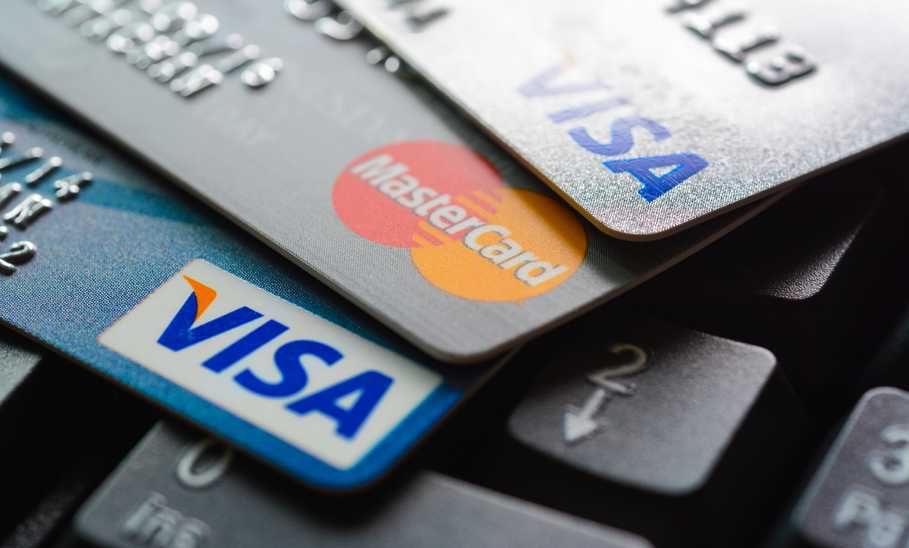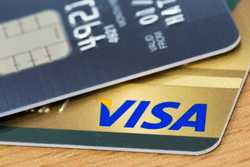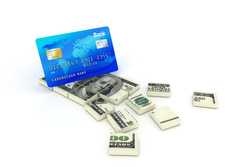History of Credit Cards: A Brief Overview

Our evaluations and opinions are not influenced by our advertising relationships, but we may earn a commission from our partners’ links. This content is created by TIME Stamped, under TIME’s direction and produced in accordance with TIME’s editorial guidelines and overseen by TIME’s editorial staff. Learn more about it.
Using a credit card for purchases is incredibly common these days—so common, in fact, that a September 2021 Consumer Financial Protection Bureau (CFPB) report said that more than 175 million Americans had at least one credit card in their name. Whether using plastic to shop online or carrying a credit card around for simple, in-person purchases, credit cards make shopping more convenient, with the potential for rewards and other perks built into each transaction.
That said, the way credit cards work now is massively different from how they began. And the concept is a lot older than most people imagine.
Some of the very first credit cards recorded in history were found in ancient Mesopotamia. These cards were actually clay tablets that were treated like lines of credit and traded with neighboring civilizations. Reporting from the Archaeological Institute of America shows that ancient Mesopotamians inscribed these clay tablets with contracts, their business information, and details on financial transactions made.
The finely preserved clay tablets date back close to 5,000 years and show how early commerce may have worked throughout various parts of the world from 2000 to 1750 B.C. Essentially, these early credit cards paved the way for official transfers of money and goods that were sometimes facilitated by debt and used for commercial purposes.
Other forms of trade and lines of credit were used throughout ancient civilizations and into early modern times. Some would consider them a precursor to the credit cards people use today. For example, a form of borrowed currency called "letters of credit" came into existence in Europe in the early 1800s. These letters of credit were purchased from banks and offered to others as a form of payment for goods and services. The bank had to guarantee to make payment if the full letter of credit wasn't paid off by the borrower. Banks charged the purchaser of a letter of credit fees to cover the risk taken on.
How did letters of credit work? Imagine a consumer of the 1800s who travels and wants to purchase a piece of furniture or a commodity like sugar or wheat with a foreign currency. Instead of paying the merchant directly, they could have had their bank draw up a letter of credit to give to the merchant for payment. The purchaser then owed the bank the money it borrowed, plus fees for the letter of credit. However, the bank was ultimately responsible for paying the bill if the purchaser disappeared without meeting their end of the bargain.
While letters of credit were eventually replaced by the earliest credit cards and other forms of credit, travelers checks became a modern form of this currency.
America's history with credit shows its earliest signs in the late 1800s, when stores began issuing paper "loyalty cards" that worked as a line of credit of sorts.
In 1914 Western Union introduced a product called "Metal Money," which turned out to be one of the first consumer credit cards. These metal plates essentially let consumers defer payments on some of the money they owed, similar to the credit cards and lines of credit we use today. In the 1920s individual firms such as oil companies and hotel chains also began issuing lines of credit to consumers in various forms.
Then, in the 1930s, something called the "Charga-Plate" came into circulation. Each Charga-Plate was a 2.5 inch by 1.25 inch rectangular sheet of metal that was used to record information about a customer, such as their name and where they live. The customer would also sign a small piece of paper as they used the Charga-Plate to make purchases. According to the National Museum of American History, Charga-Plates were developed as early as 1928 and issued throughout the 1930s to 1950s.
One of the next iterations of the modern credit card arrived in 1950. The Diner's Club Card became the "first multipurpose charge card" that year after a businessman named Frank McNamara forgot his wallet during a dinner out in New York City. McNamara and a partner worked together to come up with a solution that could help Americans avoid similar embarrassment, and they came up with the Diners Club Card. According to Diners Club International, membership for the card expanded to major cities and reached 42,000 within the next year and continued growing from there.
The Diners Club Card was probably the first "modern" credit card in circulation, at least when it comes to the type of cards we know today. Seeing its success a range of large financial institutions and other companies began issuing their own forms of cards.
American Express was reportedly one of the first major players to issue its own charge cards, which it did in 1958. Public interest was so substantial that American Express issued 250,000 of its cards before the official launch date, despite the card's high annual fee ($6 at the time).
Encyclopedia Britannica reports that Bank of America also got into the credit card game with a product for the state of California that same year. Then, in 1966, Bank of America's card products were able to be licensed and used in other states, and the name was eventually changed to Visa.
Britannica data shows many bank credit card plans that were first offered on a small scale or regional basis became affiliated with major national bank chains, which meant that credit "was no longer limited by location."
In 1966 a group of competitors formed the “Interbank Card Association (ICA),” which ultimately became Mastercard International. The ICA worked together to introduce the Master Charge shortly after, which saw a name change to Mastercard in 1979.
Mastercard and Visa are the two biggest credit card networks in operation today, but there are also cards operating on the American Express and Discover networks. Other banks and financial institutions also joined the credit card game, including Bank of America, Capital One, Chase, and Wells Fargo, to name a few of the biggest players in the market today.
American Express issued the first credit card made of plastic in 1959, and Diner's Club began issuing a plastic version of its cards in 1961. Credit card magnetic stripes were created by IBM in the early 1960s as a means to store customer and transaction history and information.
Essentially, the magnetic stripe took its form after an IBM engineer named Forrest Parry struggled to figure out how to store and transfer data with a credit card. His wife, who was ironing at the time, recommended he iron the required storage component onto credit cards in order to essentially "melt" it on. It worked.
EMV is short for Europay, MasterCard, and Visa, and EMV technology is what came after the magnetic stripe. This secure payment technology was developed in 1994, and it's still used today by top credit card, debit card, and prepaid card products.
Essentially, EMV credit cards use a chip to store customer and transaction data instead of a magnetic stripe. Some EMV cards are considered "chip and signature," meaning they require a signature for transactions, whereas others are "chip and pin" and require a pin number instead. Either way, EMV credit cards became popular in Europe first before spreading elsewhere in the world, including the United States.
EMV chip credit cards remain popular today because the smart chips embedded in the cards provide more safety and sophistication than credit cards with magnetic stripes. The chips embedded in these cards are also tamperproof and unable to be duplicated, unlike credit cards with magnetic stripes.
EMV chip credit cards in use today allow you to "dip" your credit card into a payment terminal in order for a transaction to be processed, which is a new take on older magnetic stripe cards that were "swiped" instead. Many EMV chip credit cards available today also offer contactless payment options that let you simply "tap" your credit card on a payment terminal to make a purchase.
The earliest issuers of credit cards and lines of credit didn't have any way to gauge a consumer's creditworthiness other than using their personal judgment and the reputation of a borrower. The invention of credit reports and credit scores ultimately solved this problem. Modern credit reports list a range of information about consumers, including their balances owed, payment history, and other personal data. And today's credit scores are a three-digit number meant to show banks and other lenders a digital representation of a consumer's credit health.
According to the Fair Isaac Corporation (FICO), the original versions of credit scores came into being in the 1800s. As long ago as 1841, the Mercantile Agency—an early credit bureau for businesses that eventually became Dun & Bradstreet—began soliciting information about consumers in order to begin creating profiles that relayed their individual "character and assets."
Bill Fair and Earl Issac created the first credit scoring system through the Fair Isaac Company in 1956, but the modern FICO scoring system wasn't actually released to the public until 1989. There have been many iterations of FICO scores since those early days, and many changes have come with them.
Other popular credit scoring models available today include the VantageScore credit scoring system. That said, FICO scores are still considered the standard when it comes to determining a person's credit with these scores used by 90% of top lenders.
Over the years a range of credit card legislation has helped shape the credit card market we know today. Most legislation was passed to protect consumers from predatory practices. Racism was rampant within the earliest days of the credit card industry, as detailed by the North Carolina Law Review. And it took until 1974 for the Equal Credit Opportunity Act to prohibit race-based credit decisions, as well as practices requiring women to have a male cosigner to get a credit card.
The expansive and transformative credit card legislation passed in the last 50 years includes the following:
The Truth in Lending Act (TILA) of 1968 helped protect consumers by requiring lenders and credit issuers to disclose all relevant information about the terms and costs of their loan products. The act also standardized how borrowing costs are calculated and shared with the public. The TILA protects consumers with both credit cards and all other types of loans—personal loans, mortgage loans, auto loans, and more.
The Fair Credit Billing Act (FCBA) was designed to amend and improve upon the TILA. This law requires the acknowledgement and investigation of billing errors by creditors while protecting consumers from unfair and unlawful retaliation that can impact their credit standing. According to the Federal Trade Commission (FTC), the FCBA also requires creditors to promptly post payments made by consumers to their accounts, and then either refund overpayments or credit to their accounts payments made that are above amounts due.
Note that the FCBA only applies to open-end credit accounts, including credit cards, charge cards, and home equity loans.
According to the U.S. Department of Justice, the Equal Credit Opportunity Act (ECOA) prohibits creditors from discriminating against applicants on the basis of race, color, religion, national origin, sex, marital status, and age. It also prohibits discrimination based on whether a credit applicant receives public assistance.
The Fair Debt Collection Practices Act of 1977 standardizes debt-collection procedures while protecting consumers from unfair and deceptive practices. It enacted a broad swath of changes that affect how lenders and debt collection companies can pursue unpaid debts, such as banning debt collectors from engaging in harassing or abusive behavior and prohibiting the use of false or misleading information in order to collect on unpaid debts.
The Fair Debt Collection Practices Act also sets standards for when and where consumers can be contacted for the purpose of debt collection, and it allows consumers to opt out of most debt-collection communications by informing debt collectors of their wishes in writing.
The Credit Card Accountability Responsibility and Disclosure Act of 2009 (also called the “CARD Act”) is another amendment to the TILA. This act protects consumers from additional unfair practices relating specifically to credit cards and their terms and conditions. The CARD Act required more transparency among credit card terms and practices overall, and it added limits to charges and interest rates charged by credit card companies.
The CARD Act also requires additional information to be shared with consumers in order to help them make informed decisions about their finances. For example, credit card companies are now required to tell their customers how long it would take to pay off their current balances each billing cycle if they made only the minimum payment. The CARD Act also prohibits credit card companies from increasing interest rates on future purchases or existing balances without notification in advance.
Credit card legislation and the invention of EMV chip technology and contactless payments, has made using credit cards safer and more convenient than ever before. Expect more changes to the way credit cards process information and secure our data in the coming years, based on the current trajectory of technological advances.
In the meantime today's credit card issuers are constantly innovating. We’re seeing new and improved credit card perks and features, as well as rewards programs made to fit what consumers really want the most.
One of the most recent innovations: virtual card numbers, which are typically offered for one-time purchases and aim to protect consumer's personal and financial data during each transaction. Capital One's virtual assistant Eno offers this option; numbers offered through the platform disguise your actual card number to protect you from fraud when you shop online.
Also note that digital banking in general is on the rise. Recent reports from Facts and Factors show that the size of the global digital banking market could expand from $7.9 trillion in 2021 to $10.3 trillion by 2028.
The fact that the history of credit cards goes back thousands of years shouldn't surprise you. After all, consumers wanting to spread out payments for items they need is nothing new. Today's consumers get to add rewards to the benefit of using credit for convenience.
Some of today's credit cards offer such tempting perks as airport lounge access, annual travel credits, elite status with hotels, and more. The key to getting the most out of credit cards is learning to use them responsibly and avoiding long-term debt when you can. How you use credit cards determines if they will help or hurt you financially.
The best credit card for you depends on the benefits and features you want the most, as well as whether you want to earn rewards for spending. Make sure to shop around before you decide on one, including balance transfer credit cards, rewards credit cards, and more.
Popular alternatives to credit cards include debit cards and cash. If you need to borrow money, you can also look into personal loans, home equity loans and home equity lines of credit (HELOCs).
Focus on paying more than the minimum payment each month while refraining from using your cards for new purchases. You can also consolidate and pay down credit card debt at a 0% annual percentage rate (APR) with a balance transfer credit card.
The information presented here is created by TIME Stamped and overseen by TIME editorial staff. To learn more, see our About Us page.



